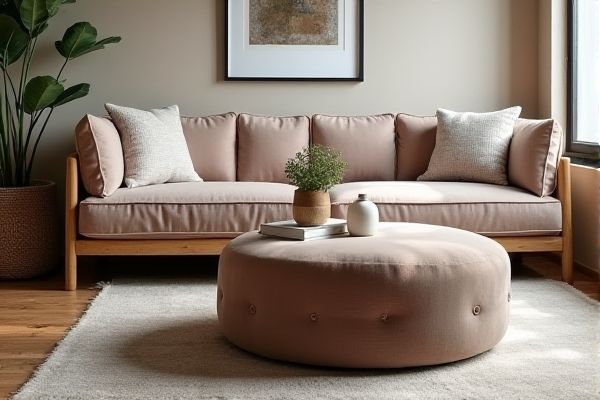
Ottoman and coffee table serve different purposes in your living space; ottomans offer versatile seating and extra storage, while coffee tables provide a stable surface for drinks and decor. Discover which piece best suits your style and needs by exploring the rest of the article.
Table of Comparison
| Feature | Ottoman | Coffee Table |
|---|---|---|
| Function | Multipurpose: seating, footrest, storage | Surface for drinks, decor, books |
| Design | Upholstered, cushioned, soft top | Hard surface, various materials (wood, glass, metal) |
| Storage | Often includes internal storage space | Rarely includes storage |
| Placement | In front of seating, flexible spots | Centered in living room, under seating |
| Style | Traditional to modern, plush look | Modern to classic, functional aesthetic |
| Material | Fabric, leather, velvet covers | Wood, glass, metal, stone surfaces |
Ottoman vs Coffee Table: Key Differences
Ottomans and coffee tables serve distinct functions in living spaces, with ottomans primarily designed as upholstered footrests or additional seating, while coffee tables provide a hard surface for placing items. Ottomans often feature soft padding and may include storage compartments, enhancing their multifunctionality, whereas coffee tables are typically crafted from wood, glass, or metal and emphasize stability and surface space. The choice between an ottoman and a coffee table depends on the desired balance of comfort, storage, and surface utility in a room's layout.
History and Evolution of Ottomans and Coffee Tables
Ottomans originated in the Ottoman Empire during the late 18th century as multifunctional upholstered pieces used for seating or footrests, often featuring rich fabrics and intricate designs. Coffee tables emerged in the early 20th century in the United States and Europe as low tables placed in living rooms to hold beverages, books, and decorative items, evolving from traditional occasional tables. Both furniture types have transformed over time, with ottomans incorporating storage and coffee tables embracing diverse materials and styles to suit modern interior design trends.
Materials Used: Ottoman vs Coffee Table
Ottomans typically feature upholstery materials such as leather, fabric, or velvet, often with cushioned padding for comfort, while coffee tables are primarily crafted from solid wood, glass, metal, or engineered wood for durability and style. The choice of materials in ottomans emphasizes softness and versatility, whereas coffee tables prioritize sturdiness and surface functionality. Your selection between an ottoman and coffee table should consider the desired material texture and practical use in your living space.
Style and Design Variations
Ottomans offer versatile style and design options, ranging from traditional tufted leather to contemporary fabric-covered models, often doubling as storage units or extra seating. Coffee tables come in an array of materials including wood, glass, and metal, with designs varying from minimalist modern to ornate vintage, typically emphasizing surface space for decor or functionality. Your choice between an ottoman and a coffee table depends on how you prioritize comfort, utility, and aesthetic appeal in your living space.
Functionality and Versatility Compared
An ottoman offers multifunctional use as a footrest, extra seating, and often hidden storage, making it highly versatile in living spaces. A coffee table primarily serves as a surface for drinks, snacks, and decorative items but lacks the added storage and comfort features of an ottoman. Your choice depends on whether you prioritize practicality and adaptability or a traditional surface for casual use.
Space Optimization: Which Fits Your Living Room?
Ottomans provide versatile space optimization by offering dual functionality as seating and storage, making them ideal for compact living rooms. Coffee tables, while stylish and practical for placing drinks or decor, often lack built-in storage and can occupy more floor space. Your choice depends on maximizing usable room while balancing comfort and organization needs.
Comfort and Practicality: Ottoman or Coffee Table?
Ottomans provide superior comfort with cushioned tops that double as footrests or extra seating, making them ideal for relaxation. Coffee tables offer practical surfaces for placing drinks, snacks, or decorative items, enhancing room functionality. Choosing between an ottoman and a coffee table depends on whether comfort or surface utility is the priority in your living space.
Storage Solutions: Hidden Benefits
Ottomans with built-in storage compartments provide a versatile solution for decluttering living spaces by concealing blankets, magazines, and remote controls. Coffee tables equipped with drawers or shelves offer easy-access storage while maintaining surface functionality for drinks and decor. Both furniture types enhance organization, but ottomans uniquely combine comfort with hidden storage, optimizing small room layouts.
Maintenance and Durability Considerations
Ottomans typically feature upholstered surfaces that require regular vacuuming and spot cleaning to maintain fabric integrity, while coffee tables often need periodic polishing or sealing depending on the material such as wood, glass, or metal. Durability of an ottoman is influenced by the quality of cushioning and fabric, which may wear faster under heavy use compared to solid coffee tables known for their sturdiness and resistance to impact. Both furniture pieces benefit from protective treatments: ottomans with stain repellents and coffee tables with surface guards to extend lifespan and preserve appearance.
Choosing the Right Option for Your Home
Choosing between an Ottoman and a coffee table depends on your home's style and functionality needs. Ottoman pieces provide versatile seating and storage options, perfect for cozy living spaces, while coffee tables offer a stable surface ideal for serving drinks and displaying decor. Consider your room layout and daily activities to select the option that best complements Your lifestyle and enhances your living area.
 homyna.com
homyna.com